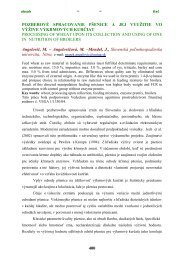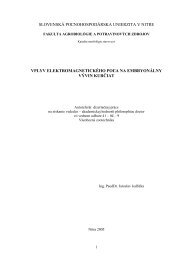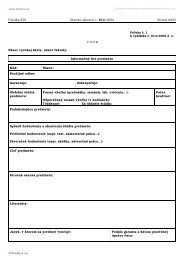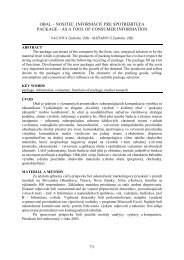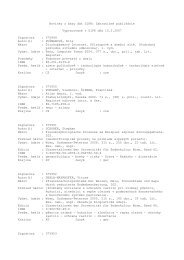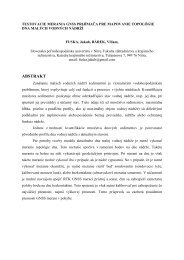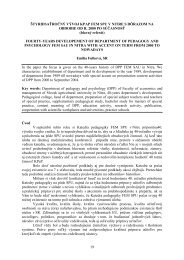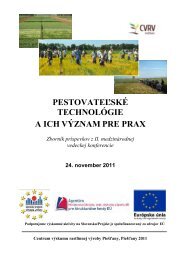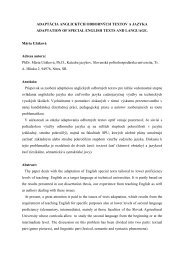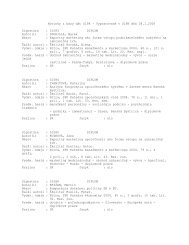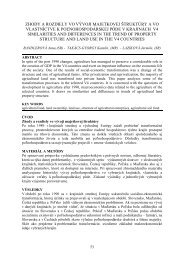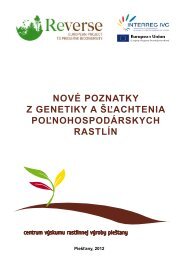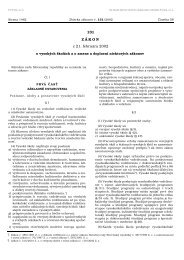Acta fytotechnica et zootechnica, Vol. 4, 2001, Special Number ...
Acta fytotechnica et zootechnica, Vol. 4, 2001, Special Number ...
Acta fytotechnica et zootechnica, Vol. 4, 2001, Special Number ...
Create successful ePaper yourself
Turn your PDF publications into a flip-book with our unique Google optimized e-Paper software.
<strong>Acta</strong> <strong>fytotechnica</strong> <strong>et</strong> <strong>zootechnica</strong>, <strong>Vol</strong>. 4, <strong>2001</strong>, <strong>Special</strong> <strong>Number</strong><br />
Proceedings of the International Scientific Conference on the Occasion of the 55 th Anniversary of the Slovak Agricultural<br />
University in Nitra<br />
Table 2 Analysis of Variance of BAP Effect on the Axillary Sshoot <strong>Number</strong>s<br />
Source Sx 2 N V F<br />
Cultivation<br />
159.0000 3 32.4375 25.6700 **<br />
medium<br />
Rep<strong>et</strong>ition 3.1875 3 1.0625 0.2920<br />
Residual 29.3750 9<br />
Total 191.5625 15<br />
*** = high significance F 0.05 = 3.9 F 0.01 = 7.0<br />
mm multiplied by number of shoots) was found at the concentration 1.0 mg.l -1 BAP that was 160.74 % higher than control<br />
treatment. Table 3. shows results from the follow-up experiment in which the best treatment from the first experiment<br />
(MS+1.0 mg.l-1BAP) was used as control. The highest number of axillary shoots 4.75 was found at the concentration 0.2<br />
mg.l -1 of NAA. In comparison with the control experiment (MS+BAP) these results mean increase by 18.75 % but in<br />
comparison with control from the first experiment (MS) by 375 %. However, statistically high significant differences were<br />
found b<strong>et</strong>ween the lengths of axillary shoots ( Table 4.).<br />
Table 3 The Influence of NAA Concentration on the Multiplication of P. suffruticosa cv.Comtesse de Tuder<br />
mg.l -1<br />
of NAA<br />
<strong>Number</strong><br />
of Shoots<br />
(pieces)<br />
% to<br />
Control<br />
Length<br />
of Shoots<br />
(mm)<br />
% to<br />
Control<br />
Vitrification<br />
(%)<br />
% to<br />
Control<br />
Efficiency<br />
(pieces x<br />
Ø length)<br />
% to<br />
Control<br />
0.0 4.00 100.00 8.20 100.00 18.37 100.00 32.80 100.00<br />
0.1 4.00 100.00 10.92 133.17 15.03 81.82 43.68 133.17<br />
0.2 4.75 118.75 12.47 152.07 16.07 87.48 59.23 180.58<br />
0.5 3.75 93.75 7.90 96.34 50.01 272.24 29.63 90.34<br />
Table 4 Analysis of Variance of NAA Effect on Axillary Shoots Length<br />
Source Sx 2 N V F<br />
Cultivation medium 1620.5384 3 61.0783 88.0345 **<br />
Rep<strong>et</strong>ition 0.9683 3 0.3228 1.4664<br />
Residual 1.9810 9<br />
Total 1623.4876 15<br />
** high significance<br />
F 0.05 = 3.9<br />
F 0.01 = 7.0<br />
The longest axillary shoots (12.47 mm) were obtained on MS-medium supplemented with 0.2 mg.l -1 NAA, that means they<br />
were longer by 52.07 % in the comparison with the control shoots. The concentration of 0.5 mg.l-1 NAA had negative effect<br />
on the length of the axillary shoots. Vitrification reached 272.24 % in comparison with the control after 5 weeks in culture.<br />
With increased NAA concentration (up to 0.2 mg.l -1 ) the efficiency of the axillary shoots induction increased as well. In<br />
comparison with the control treatment (MS+BAP) it was higher by 80.58 % and with the other one (MS-hormone free<br />
medium) even higher by 354.22 %.<br />
Discussion<br />
The concentration of 1.0 mg.l -1 BAP in MS medium can be recommended for the induction of the axillary shoots for P.<br />
suffruticosa in “in vitro” conditions. The low BAP concentrations for multiplication of P. suffruticosa were used also by Bouza<br />
<strong>et</strong> al. (1993) and Harris & Mantell (1991). In our experiments where BAP was applied induction of the adventive buds were<br />
occurred on the basip<strong>et</strong>al side of the internodal peony stem segments. These basip<strong>et</strong>al stem segments became swollen and<br />
here calli was produced. Later adventive buds there regenerated in this area of the explants. The similar way of the<br />
regeneration published Yulong <strong>et</strong> al. (1984), Harris & Mantell (1991) and Bouza <strong>et</strong> al. (1993) after application cytokinins to<br />
the culture medium for P. suffruticosa. Krejcí & Franc (1997) and Franc (1998) recommend for more woody species to add<br />
auxins in the low concentrations to the medium. In our experiments an increased apical dominance effect occurred at the<br />
53



